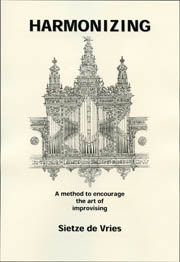Last week, we looked at Harmonizing: A Method to Encourage the Art of Improvising by Sietze de Vries. It focused primarily on basic chords in the same key as the melody. Today, I’d like to offer an idea on developing a tonal vocabulary more in the style of Jean Langlais.
Building Chords
Common practice harmony uses chords built by thirds. When choosing how to harmonize a melody note, it typically is the root, third or fifth of a chord. Eventually, we could consider the possibility that it is a seventh, ninth, or a non-chord tone, but we’ll keep it simple for now. Keeping only to major and minor triads, this will give us six options of how to harmonize a single melody note:
Using our chorale Lobt Gott den Herrn, ihr Heiden all from last week, our first step will be to harmonize the theme with one of the six chord types all the way through. Here is the first phrase with the melody as the root of a major triad:
Play through the entire chorale using each of the six types of chords one at a time (Root of a major chord, root of a minor chord, third of a major chord, and so forth). Enjoy the cross relations like the C# and C natural in the second measure above. Eventually, you can venture into diminished and augmented triads, or even seventh chords:
Once you can consistently apply one chord type to the melody, it’s time to start looking for different progressions that will provide the most interesting colors. If the melody note stays the same, be sure and change the type of chord (from root of a major chord to third of a major chord for example).
Lobt Gott den Herrn is a very stepwise melody. Be sure and practice with other themes that include mores skips (especially thirds!) in them so that you are very comfortable with the cross relations that develop from keeping the chord type consistent. You can practice this using only one hand at a time (Yes, you should do it with your left hand alone!), both hands playing the same notes, or eventually right hand chord with left hand (or pedal!) playing the root. This last one can become particularly tricky once you start changing chord types. Remember the instruction from Naji Hakim (a student of Langlais): “Never play faster thank you can think.”
Finally, add a little rhythm, a few manual or registration changes, and you are well on your way to creating a piece like the Pasticcio from Langlais’ Organ Book or the Dialogue sur les mixtures from Suite Brève.
Hoping your harmony is colorful!
Glenn Osborne
Recent additions to organimprovisation.com:
I’ve added a new section to the store with recordings of piano improvisations in classical styles. It includes recordings by Gabriela Montero, Ola Gjeilo, and my favorites by John Bayless on Happy Birthday and tunes by The Beatles
.
Organists:
Themes:
Newsletter Issue 7 – 2014 06 09
See the complete list of past newsletter issues here.
Sign up to receive future issues using the box to the right on this page.







